Traveling internationally with your RV or camper opens up a world of adventure, but it requires careful planning and understanding of local driving regulations. This guide will cover the essential aspects of licensing, vehicle transportation, campsite finding, and other important considerations for a successful journey.
Transporting Your RV or Camper
Once you’ve sorted out your licensing requirements, the next consideration is whether to ship your RV or camper overseas or rent one locally.
Shipping Your Vehicle
Shipping your vehicle can be complex and costly. You’ll need to choose between roll-on/roll-off (RoRo) shipping, which is common for vehicles, and container shipping for smaller campers. Finding a reliable shipping company experienced in handling RVs is crucial, as is preparing all necessary documentation, including your vehicle’s title, registration, and potentially a bill of sale. Understanding the customs and import regulations of your destination country is essential, as is securing adequate shipping insurance to cover any potential damage.
Renting or Buying Locally
In many cases, renting or buying a camper locally can be more convenient and cost-effective. Major rental companies like McRent in Europe, Britz in Australia and New Zealand, and Cruise America in the USA offer a range of options. For longer stays, buying a used camper locally can be an economical choice, but be sure to understand local registration and insurance requirements.
International Driving Permits and Licensing
One of the first things to consider is whether you need an International Driving Permit (IDP) in addition to your U.S. driver’s license.
In North America, your U.S. driver’s license is generally sufficient for travel in Canada and Mexico. However, it’s a good idea to obtain an IDP for Mexico to ensure smooth interactions with local authorities.
Moving to Europe, most European Union (EU) countries accept a U.S. driver’s license for short stays, but having an IDP is advisable as it translates your license into various languages, making it easier to deal with local authorities. Non-EU countries often require an IDP, so checking specific country requirements in advance is essential.
Traveling in Asia presents different challenges. In Japan, South Korea, and Taiwan, an IDP is mandatory. Your U.S. license alone will not be sufficient. In Southeast Asian countries like Thailand and Malaysia, an IDP is generally required, though regulations can vary. China does not recognize U.S. licenses or IDPs, necessitating a local license which typically involves obtaining a temporary driving permit.
In Latin America, an IDP is recommended alongside your U.S. license. While many countries accept a U.S. license, regulations can vary, and having an IDP can prevent potential issues.
In Australia and New Zealand, your U.S. license is accepted for up to 12 months, but an IDP is beneficial for clarity.
Across Africa, an IDP is generally recommended as requirements can vary significantly by country.
In the Middle East, countries like the UAE and Saudi Arabia often require an IDP, though some may accept a U.S. license for rental purposes. Always verify specific requirements for each country you plan to visit.
Finding Campsites
Google Maps
Google Maps is a great tool for finding campsites. Simply search for terms like “campgrounds” or “RV parks” along your route. Reviews and photos can help you choose the best spots.
Dedicated Apps and Websites
- Campendium: Provides a comprehensive directory of campgrounds, including user reviews and detailed information.
- iOverlander: Offers a community-driven database of campsites, including more off-the-beaten-path options.
- Park4Night: Popular in Europe, this app helps you find camping spots, parking areas, and service points.
- Allstays: A comprehensive app that lists campgrounds, rest areas, and RV-friendly stores across North America.
Additional Tips
Local Regulations and Customs
Understanding local regulations and customs is crucial when camping. Always check local rules regarding camping, as wild camping is allowed in some countries (e.g., Norway, Sweden) but prohibited in others.
Safety and Security
Always lock your vehicle when leaving it unattended and use additional security measures if possible. Stay informed about local news and travel advisories for your destination.
Connectivity
Consider getting a local SIM card or an international data plan to stay connected. Download offline maps for your GPS or use apps like Maps.me which offer offline navigation capabilities.
Budgeting
Fuel prices can vary significantly. Research prices along your route to budget accordingly. Some campsites can be expensive, especially in popular tourist areas. Look for free or low-cost options when possible.
Traveling the world in an RV or camper can be an incredible adventure, offering unparalleled freedom and flexibility. With proper planning and preparation, you’ll be ready to explore new destinations with confidence and ease. Safe travels!




[fluentform id="6"]